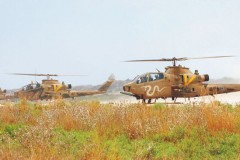Second Lebanon War
The Second Lebanon War (Hebrew: מלחמת לבנון השנייה, 'Milhemet Levanon HaShniya') was a war between the IDF and the Hezbollah terrorist organization from July 12 to August 14, 2006. The objective of the war was to return tranquility to the citizens of northern Israel by ceasing Hezbollah rocket fire, as well as releasing the two Israeli soldiers kidnapped by Hezbollah on July 12.
1. Beginning of the War
2. History of the War
3. End of the War
4. Exchange of Prisoners
![]()

1.The Beginning of the War
At approximately 9 a.m. on July 12, 2006, the Hezbollah terrorist organization launched a combined attack in Israeli territory on the northern border, targeting an Israeli army patrol consisting of two armored jeeps near the border fence between the villages of Shtoula and Zar'it.
The terrorists entered, killed 3 IDF soldiers, and kidnapped 2 other reservist soldiers, who were wounded during the attack, and taken back to Lebanese territory. The captured soldiers were Eldad Regev (26) from Kiryat Motzkin, and Ehud Goldwasser (31) from Nahariya. Five IDF soldiers were killed on the same day in an attempt to return the kidnapped soldiers, which failed. The Hezbollah attack on the Blue Line border was condemned by the Secretary General of the UN.
Simultaneously with its attack (and before any Israeli response), Hezbollah fired heavily on the Israeli population and IDF positions along the border with mortar shells and Katyusha rockets, killing six civilians in the Galilee.
2. The War
Later that day, the Israeli government ordered the IDF to launch a military operation in Lebanese territory, initially called "Operation Just Remission" (Hebrew: מבצע שכר הולם, "Mivtsa Skhar Holem"), to stop the firing of Katyusha rockets into northern Israel and to release the two soldiers that were captured inside Israeli borders. The IDF launched an air raid on Hezbollah's positions in Lebanon before infantry forces penetrated into Lebanese territory.
During the war, the name of the operation was changed to "Change of Direction" (Hebrew: מבצע שינוי כיוון, 'Mivtsa Shinui Kivun'). The various branches of the IDF took part in the conflict. The Ground Forces were mobilized, the Air Force multiplied the air raids and sought to evacuate the wounded soldiers, and the Navy struck Hezbollah from the Lebanese coast. The fighting continued unabated on the northern and southern fronts.
After 11 days of fighting, the IDF began mobilizing reservist soldiers. Most of them received emergency summoning orders on Friday morning, and were in uniform that same evening. The objective of the mobilization of reserve soldiers was to increase the scope of operations against Hezbollah and its infrastructure.
After three weeks of fighting, the IDF launched a bold operation, during which soldiers of the Special Forces of the Navy ("Shayetet 13") took control of the city of Tyre in order to destroy the launching ramps of rockets that had reached the Israeli city of Hadera. During the operation, an officer and a soldier were seriously wounded, but their situation stabilized.
After a month of fighting, the Israeli security cabinet ordered the military operation to be extended to Lebanon. Hundreds of IDF soldiers stationed in southern Lebanon began to head towards the Litani River. The objective of the operation was twofold: to destroy the maximum number of Hezbollah rocket launchers that could reach the northern region of Israel, where nearly one million people live, and to deeply affect the Hezbollah terrorist organization operating in Lebanese territory.
From the moment the decision to extend the military operation was taken, 80 Hezbollah command posts were attacked, dozens of rocket launchers were destroyed, and 50 terrorists were killed.
3. End of the War
At 8 a.m. on August 14, 2006, the IDF stopped its offensive in Lebanon by order of the Israeli government. This decision followed the vote of Resolution 1701 by the UN Security Council. IDF troops remained in southern Lebanon until the Lebanese Armed Forces regained control of the area, and UNIFIL and UN forces were deployed.
The Second Lebanon War killed 119 soldiers and 44 Israeli civilians. In addition, 400 soldiers and about 2,000 Israeli civilians were wounded.
The Air Force attacked 7,000 targets in Lebanon, while the Navy carried out 2,500 bombardments from the Lebanese coast.
4. Exchange of Prisoners
During the war, Hezbollah refused to give information about the two soldiers kidnapped at the beginning of the conflict. Later on, during the prisoner exchange on July 16, 2008, Israel learned that they had succumbed to their wounds. In exchange for the bodies of Eldad Regev and Ehud Goldwasser, Israel handed over the bodies of 200 Lebanese and Palestinian militants, and released four Hezbollah militants, as well as Samir Kuntar, a Lebanese militant from the PLF, who was sentenced in 1980 for murdering Danny Haran, his 4-year-old daughter Einat, and two Israeli policeman. When Samir Kuntar was released, a party was organized by Hezbollah and broadcast by the Arab television channel Al Jazeera.
During the return of the two bodies of the Israeli soldiers, then-Chief Military Rabbi, Brig. Gen. Israel Weiss, commented: "The process of identification was very long because if we thought the enemy was cruel, we were surprised, when we opened the coffins, to discover the extent of his cruelty."

